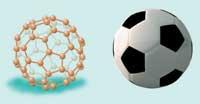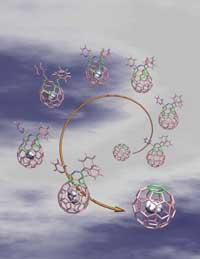Fullerenos here and there

Fullerenes are ball-shaped molecules formed by carbon. They resemble the football, that is, they are round and empty structures of 60 carbon formed by 12 pentagons and 20 hexagons (C60). English chemist Harold Kroto and his team found fullerenes in 1985 while researching the composition of the stars. Coincidentally they found a new structure: with a cage structure of 60 carbon atoms. Years later, in 1996, Professor Kroto received the Nobel Prize in Chemistry for this discovery.
Before analyzing the use of any material, it is necessary to investigate and understand its properties, since depending on its properties the material will have some uses or others. Fullerenes can collide without breaking into a steel plate at a speed of 27,000 km/h, indicating the hardness of these molecules.
However, the conductive and photochemical properties are the most important. Also, considering the ability of fullerenes to combine with other molecules, we can conclude that they are materials with enormous potential. Thanks to all these properties, they have begun to walk in the field of renewable energy.
Transportation jobs in medicine

Nobel Prize in Chemistry in 1996 for his discovery of fullerene. (NIMSoffice)
Fullerene molecules have the ability to make the cage, so the invented applications depend on what they can catch inside. Therefore, they have numerous applications, many of them still under investigation.
Especially in medicine great possibilities are foreseen. In fact, the small spherical structure of fullerenes makes them able to store atoms and small molecules inside them: heavy metals, drugs, etc. This can have a great influence on medicine, since the drugs, so collected, would reach the diseased organ without destroying it on the way and without harming other organs. Thus, for example, in the fight against cancer can become very useful. Targeted attacks on malignant cells can increase effective doses and minimize side effects.

The small spherical structure of fullerenes makes them able to store atoms and small molecules inside them. (Koichi Komatsu).
In addition, radioactive atoms may be introduced within these molecules, which would allow to add markers on the outside of fullerene to be able to transfer them to a certain location, where the radioactive atom radiates, for example, into a cancer cell.
Although these applications seem promising, they are still at a very early stage and need further research. It has already been invented how to put the molecules inside fullerene and direct them to a specific place of the organism, but it remains to be discovered what to do with fullerene after the release of the drug.
In addition to medicine, electronics can be very important. Fullerene seems useful for solar panels. It will surely serve to replace silicon. Silicon solar panels are very expensive and fullerene C60 is very good for generating electricity.
There are many chemicals that work with this molecule, but for the moment it has no direct application. However, scientists do not give up. In the case of the laser they went from 25 to 30 years until they had an application. Therefore, we may soon find human applications for the C60 molecule.
Published in 7k
Buletina
Bidali zure helbide elektronikoa eta jaso asteroko buletina zure sarrera-ontzian











